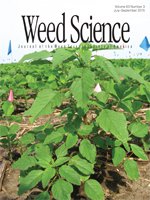Japanese brome is a winter annual weed commonly found in wheat fields in China. Laboratory and greenhouse experiments were carried out to determine the effect of temperature, light, pH, osmotic stress, salt stress, and burial depth on the germination and emergence of Japanese brome. Germination was greater than 98% under a wide temperature range of 5 to 30 C and onset of germination was shortened as temperature increased. Light was not required for germination to occur and pH values from 5 to 10 had insignificant effect on germination. Germination was reduced by osmotic stress or salt stress and no germination occurred at −1.3 MPa or 360 mM, suggesting that Japanese brome seed was quite tolerant to osmotic potential and salinity. Seedling emergence was greatest (98%) when seeds were placed on the soil surface but decreased with increasing of burial depth. Only 7% of seedlings emerged at a depth of 5 cm. The results of this study have contributed to our understanding of the germination and emergence of Japanese brome and should enhance our ability to develop better control strategies in wheat farming systems of the Huang-Huai-Hai Plain of China.
Nomenclature: Japanese brome, Bromus japonicus Thunb. ex Murr.





